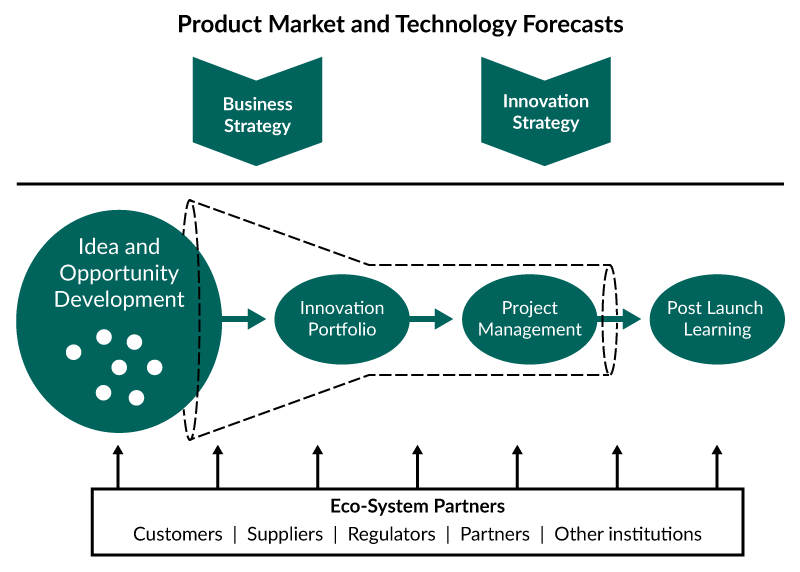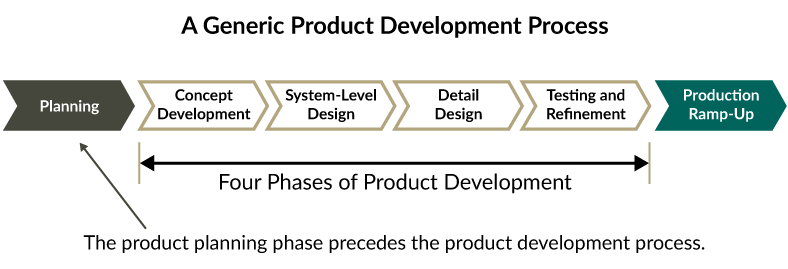Listen to an MP3
Overview of the New Product Development (NPD) Process
Sriram Narayanan
M.B.A., Ph.D.

In this presentation, we will:
- Discuss the key capabilities that organizations need to pursue innovation
- Demonstrate the importance of innovation strategy and delineate the components of strategy execution
- Describe a generic product development process
- Summarize the activities and variants of the product development process
Presentation Outcomes
Why Organizations Should Have Innovation Strategies
Why should organizations have innovation strategy? Strategy serves a number of purposes. First, it tries to align stakeholders within the corporation and direct resources. Second, it provides a way for people to get on the same page.
What organizations may be involved in innovation projects? The R&D department, marketing, the supply chain department, customers, suppliers, and other external entities. These entities could include university or foreign labs, or research facilities that possess specialized capabilities. Alignment of stakeholders is an important component of innovation strategy.
What Does an Innovation Strategy Help Achieve?
What does an innovation strategy help achieve? It sets the tone for a firm’s innovation efforts. It sets goals, and details key markets and steps that firms can take in achieving those goals. It also clarifies the domains that companies may operate in so as to appropriately direct investments. ![]() For example, Apple operates in PC markets, cell-phone markets, and tablet markets. According to some public websites, they are also trying to develop autonomous cars; that would be another domain Apple would be operating in. When organizations clarify the domains, they also can direct their investments. An innovation strategy defines the engagement of internal and external stakeholders.
For example, Apple operates in PC markets, cell-phone markets, and tablet markets. According to some public websites, they are also trying to develop autonomous cars; that would be another domain Apple would be operating in. When organizations clarify the domains, they also can direct their investments. An innovation strategy defines the engagement of internal and external stakeholders.
What do we mean by internal and external stakeholders? Internal stakeholders are R&D, marketing, the supply chain department, and so on. External stakeholders are primarily companies or individuals outside the organization. These could be customers, suppliers, or foreign research labs. An innovation strategy also details how the organization is going to achieve innovation goals and the process for doing so.
Aligning Business and Innovation Strategies
Innovation strategy needs to be closely aligned with an organization’s business strategy – its overall goals, vision, and mission. In order to develop these, companies need to look at the product development funnel. It starts with idea and opportunity development, when firms identify an opportunity in the marketplace. For example, a company may discover a market for a smartphone and then identify the features customers would want on the phone.
Companies may develop different ideas and opportunities to execute; a single opportunity cannot drive the future of a company, so many firms pursue several opportunities. This collection of opportunities can be called an innovation portfolio. The returns for these projects could be different as well. When companies have a portfolio of innovations, they may manage individual innovations through projects, which requires project-management skills. We will address this in detail later in the course.
Project management is about executing the innovation project (idea) and realizing the end goal, which is the product that potentially can be sold to customers. When the project is finished, it does not end there. Post-launch learning is a key aspect of projects; this is when companies reflect on what went right or wrong, and then they record these conclusions to apply to future innovation projects.

In this innovation funnel graphic, the ecosystem partners, which we previously have discussed, are at the bottom. These are customers, suppliers, and regulators. In the drug industry, for example, regulators are a big part of the ecosystem because the agencies approve clinical trials. There could be other partners, including contract research organizations that work on clinical trials of drugs or institutions such as research labs.
A Generic Product Development Process
Now we will focus on a generic product development process, which can be adapted in different ways. Later, we will consider some nuances of the process. The first step is planning. This phase precedes the product development process. A good plan is always a great start and helps in several ways. Then, within the product development process, a concept is developed. That is followed by what is called system-level design, detail design, and testing and refinement.
 A concept essentially is a high-level sketch of an idea that does not get into the details of how the idea will be executed. Perhaps a company wants to develop a backpack, and designers have some thoughts on the overall concept of the backpack, its intended use, and more. Based on the intended use, the backpack could include several components. Against this backdrop, we will focus on key activities that different departments in a company work on in product planning.
A concept essentially is a high-level sketch of an idea that does not get into the details of how the idea will be executed. Perhaps a company wants to develop a backpack, and designers have some thoughts on the overall concept of the backpack, its intended use, and more. Based on the intended use, the backpack could include several components. Against this backdrop, we will focus on key activities that different departments in a company work on in product planning.
Key Activities in Product Planning
The emphasis here is that across the phases of product development (planning, concept development, system-level design, detail design, testing and refinement, and production ramp-up), groups such as marketing, product design, manufacturing, and others play different yet complementary roles. This has clear implications on how organizations can put together an innovation process that is efficient, and we will see this through the remainder of the course.

Eppinger, S. D. & Ulrich, K. T. (2015). Product design and development (6th ed.).
New York: McGraw-Hill Education.
Variants of the Product Development Process
The product development process includes variants. The classical product development process is divided into planning, concept development, system-level design, detail design, testing, and refinement in production ramp-up stages. However, organizations also go through multiple iterations, as shown in the Ulrich and Eppinger diagram, which depicts:
- Generic product development process
- Spiral product development process
- Complex system development process
One variant is based on a design-build-test process. Many software companies pursue these kinds of processes in which a system-level design is articulated for the software, followed by a quick design, build, and test of the product. Then they try to speed up the overall development of products by going through multiple iterations of the design-build-test cycle.
The other variation used by organizations involves looking at several parallel modules that are designed and tested simultaneously before going through a phase called integration testing. This is common in industries in which projects involve different streams of technologies that must be consolidated.
Both of these are variants of the product development process. The takeaway here is that we avoid rigidity with these different stages. It’s a flexible idea, and the product development process should somewhat be seen as a nebulous entity that articulates the steps companies must take in creating a new product.

Eppinger, S. D. & Ulrich, K. T. (2015). Product design and development (6th ed.).
New York: McGraw-Hill Education.
Conclusion
In this presentation, we:
- Discussed the key capabilities organizations need to pursue innovation
- Demonstrated the importance of innovation strategy and delineated the components of strategy execution
- Described a generic product development process
- Summarized the activities and variants of the product development process